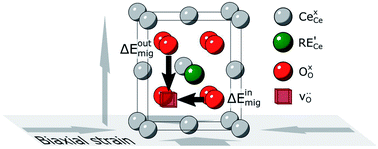Strain-modified ionic conductivity in rare-earth substituted ceria: effects of migration direction, barriers, and defect-interactions†
Abstract
It is crucial to understand how ionic transport in functional oxides is affected by strain, which may unintentionally occur during the fabrication or operation of electrochemical devices or may be intentionally engineered for improved functional properties. In this work, the change in ionic conductivity of biaxially strained epitaxial films of rare-earth substituted ceria was measured. By thermally annealing strained epitaxial films, the strain state was varied, and the conductivity was extracted without contributions from grain boundaries. It is shown that transport in the out-of-plane direction, with respect to the strained axes, is more sensitive to the strain state than in the in-plane direction. In addition, the size of the rare-earth substitutionals significantly impacts the extent of the strain effect on the ionic conductivity. The conductivity was simulated by the kinetic Monte Carlo method based on energies from density functional theory to deconvolute the effects of strain on the migration barriers and defect interactions. It was revealed that both the barriers and interactions contribute to the strain-modified transport, however, it is important to take into account the long-range motion rather than individual barriers and interactions. These findings provide new generalized insights into how strain affects ionic transport in crystalline materials, which may lead to a more sophisticated approach to engineering functional oxides.



 Please wait while we load your content...
Please wait while we load your content...
